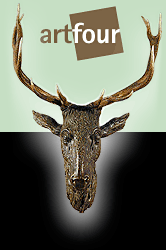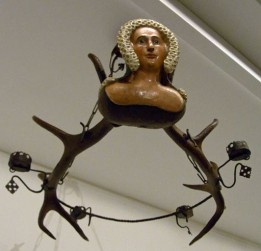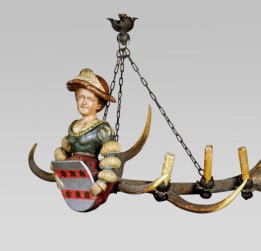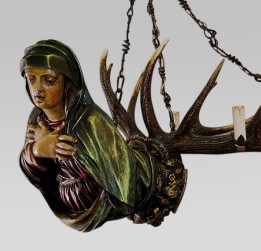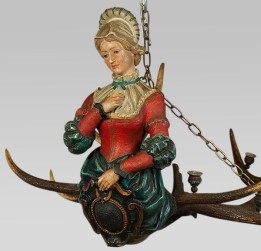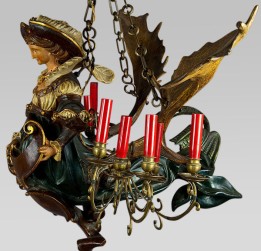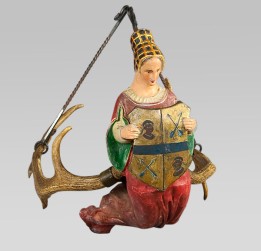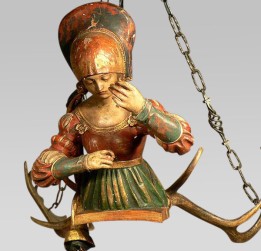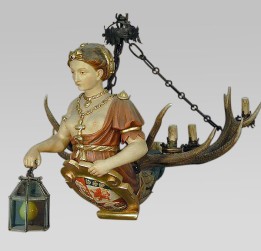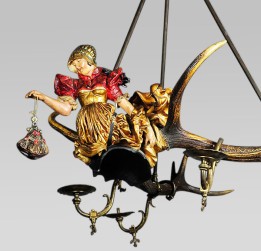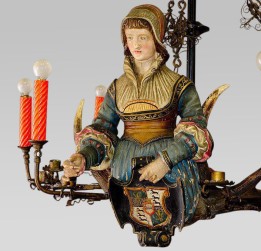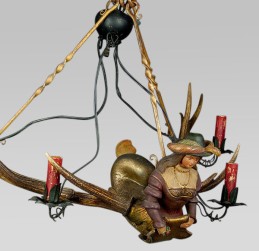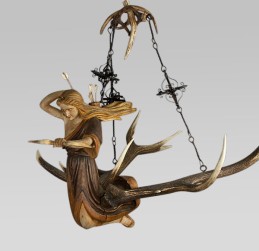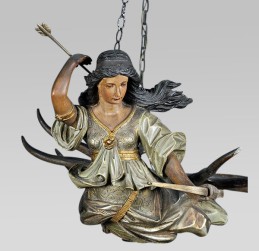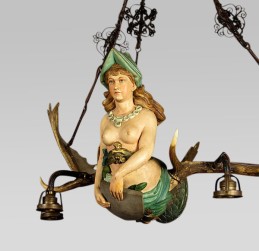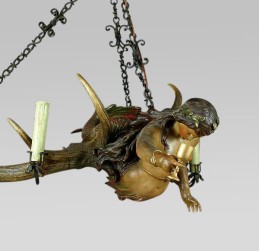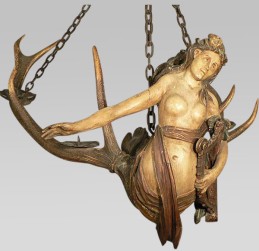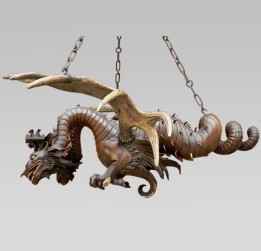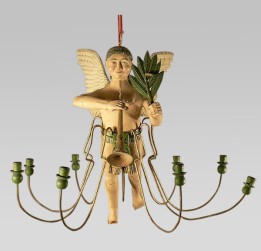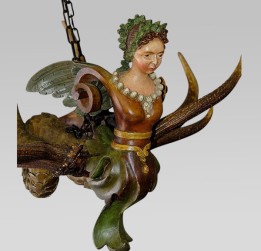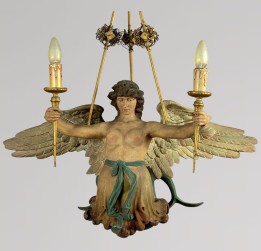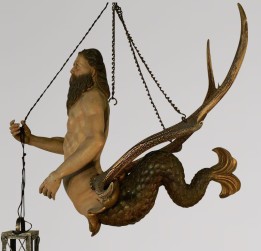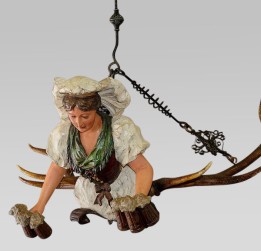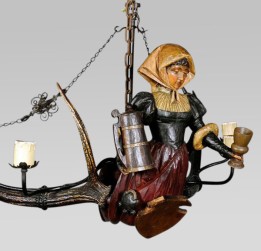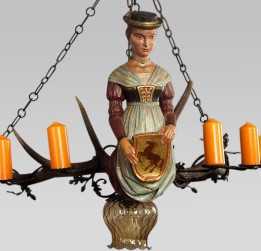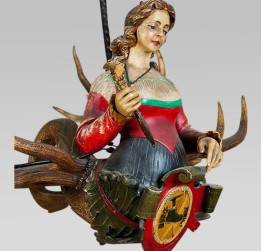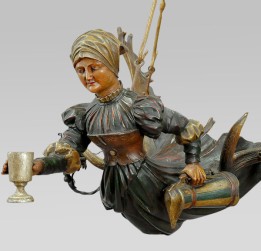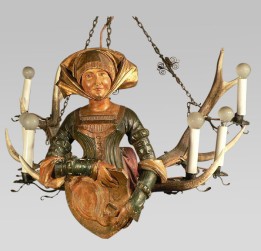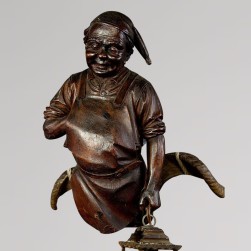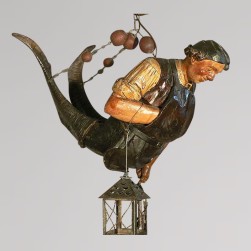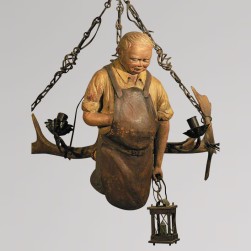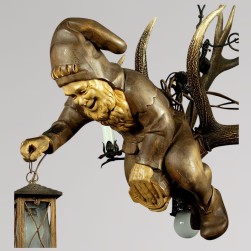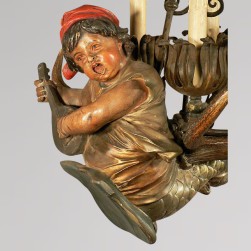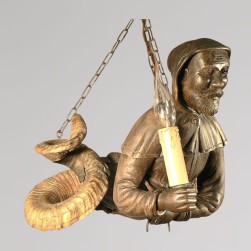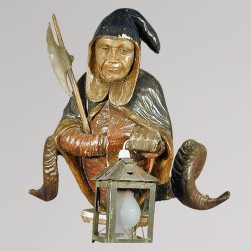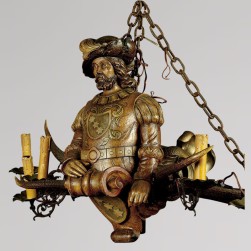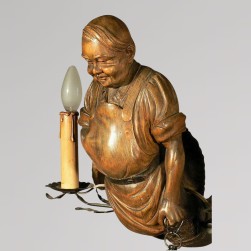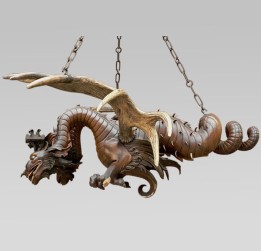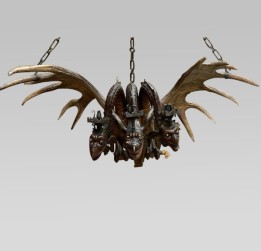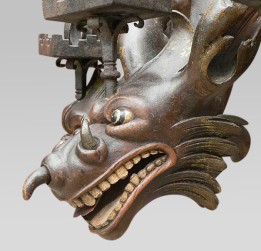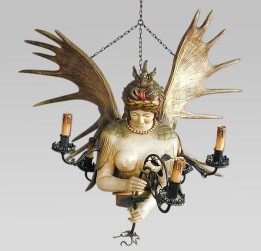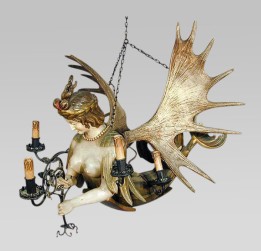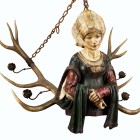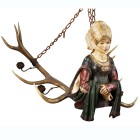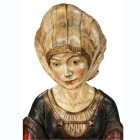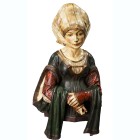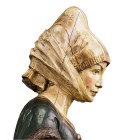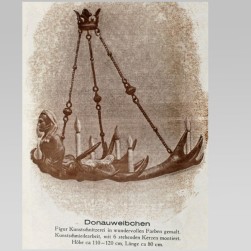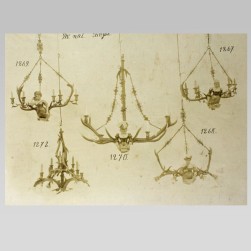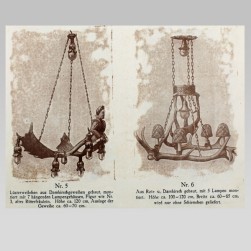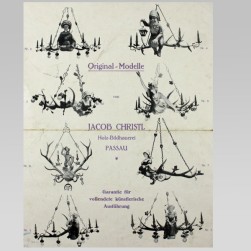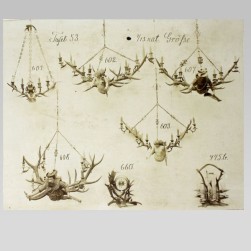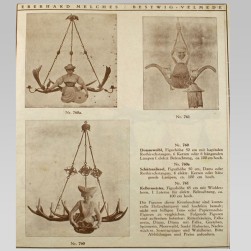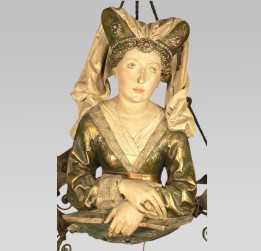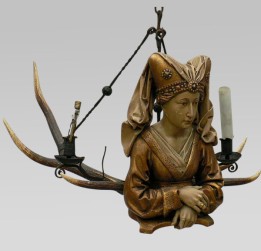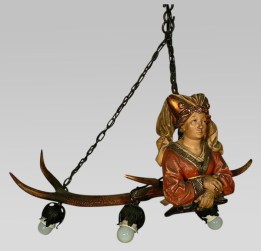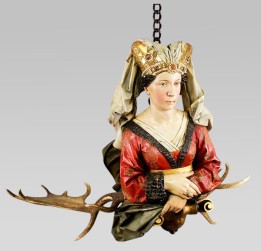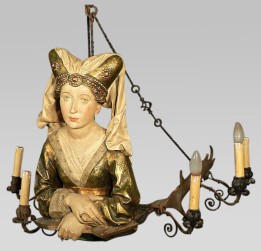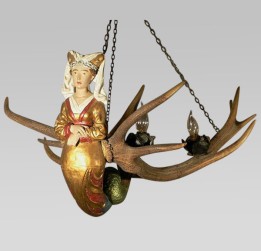about lusterweibchen
History
A characteristic example of a lusterweibchen is a wooden female bust with a lofty but pleasant glance. The sculpture is fastened with iron chains hanging from the ceiling, the body is fixed to a deer antler and shaped as a chandelier with wrought-iron candle holders. The first chandeliers which are designated to the so-called lusterweibchen can be assigned to the end of the 14th century.
In 1392 a marvellous chandelier was donated to the Marienkirche in Lemgo, Germany. A bust of a woman made by an unknown master, at her shoulders a pair of capital 12end deer antlers combined with five wrought iron candle holders and a forged chain for suspension. The Lemgo lusterweibchen is considered as a master piece and has triggered a generation of marvellous followers.
The popularity for lusterweibchen in Germany increased in the 15th and 16th century. People were fascinated by the combination of art and nature and the impressive design emitted a subliminal apotropaic magic. The power of illumination was subordinate in relation to representativeness of the chandelier. Famous artists such as Veit Stoss, Albrecht Dürer and Tilman Riemenschneider designed marvellous unique lusterweibchen and set standards for many other successors.
The apotropaic magic chandeliers have experienced a rennaisance in the second half of the 19th century until the beginning of World War I. A fashionable domicile either private household or country hotel owned a hunting room which was equipped with antler furniture and decorated with lusterweibchen. During this period many imitiations of the great Gothic and Rennaissance designs have been made and luminance was generated by gas or electricity.
Today lusterweibchen have not lost any of its fascination or significance.
Categories of luesterweibchen
History provides several different types of antler & sculpture combinations. Drawn patterns of wooden sculptures are often the groundwork for the later carved lusterweibchen. There are half and or full figure busts or sometimes even groups of figures. The stature´s story varies from holy to profane. The antlers of preference are mainly from deers while roebuck antlers are obviously of no importance. The deer antler are fastened either horizontal or vertikal. The following examples try to give a broad idea of lusterweibchen categories.
Noble ladies
Lady is a civil term of respect for a woman; the female equivalant to lord or gentleman. The titel is mainly used for woman of high birth or status. A perfect synonym for the adjective noble is "very impressive or imposing in appearance". A noble lady embodies the perfect model for a lusterweibchen. Carvers have created with noble lady lusterweibchen a beautiful adornment for each room.
Diana
The Roman goddness of the hunt Diana is honored in various aspects. First of all she is known as an accomplished hunter and stood as a guardian for the forest and its animals to whom she was able to talk to. In spite of her virginal status she was later known as a protector of childbirth. Some artwork has associated Diana with the powers of the moon while she is typically portrayed carrying a bow and wearing a short tunic. Supporting the fascination for hunting rooms a diana lusterweibchen was the ideal illumination for this type of characteristic furnishing.
Mermaid
In the second half of the 16th century lusterweibchen with mermaid or siren busts became famous. The sculptures were mainly naked or fashionable dressed women. Their body was passed into a fishtail. The male counterpart to a mermaid and siren was a triton. Today the the fabulous creatures of meramid lusters do not only enchants kids.
Mystical creature
Hybrid creatures, chimeras and animal forms are summarized in mystical lusters. They represent an own unique apotropaic magic combination of art and nature. This fusing is perfectly succeeded with e.g. dragon lusters. The antlers appear to be an organic part of the mythical beast.
Guilds
Besides of churches and townhalls lusterweibchen were also used as a typical illumination for guild houses. The various different guilds created busts with typical emblems and or armamentarium. Waitress luster often show busts carrying a wine jung and were later often found in wine bars or restaurants.
Lustermaennachen
Less known and in rare cases created lusters were designed as male models, the so called lustermaennchen. They were mainly decorated in mundane rooms such as town halls or snuggeries of castles. One of the famoust examples of lustermaennchen was created in 1913 by Heinz Schiestl for the restaurant "Weinhaus zum Stachel".
Lustermaennchen were illustrated in various kinds of characteristics, e.g. monks, cellarers with either key or lamp, bellmen, musicians, huntsmen, dwarfs and or knights.
Famous artists of lusterweibchen
Veit Stoss (1447 - 1533)
Veit Stoss was a gifted carver with a moving life story. His main creative periods with outstanding pieces took place in Krakau and Nuernberg. He was conviced for falsification of documents and had to resettle several times. His famous dragon chandelier was made after submission of a design from Albret Dürer in 1522. The marvellous chandelier is made of limewood and reindeer antlers. It can be visited today in the Germanisches Nationalmuseum in Nuerberg.
Albrecht Dürer (1471 - 1528)
The world famoust artist Albrecht Dürer was the first artist who signed his graphics systematically with his initials. This pratice turned into his trademark and inspired many other artists. Albrecht Dürer has created so many unique pieces of art and the focus on lusterweibchen is based on a pen and ink drawing he made for his friend Willibald Pirckheimer in 1513. Albrecht Dürer engaged carvers to realise lusterweibchen according to his own drawings.
two examples of exceiting lusterweibchen according to Albrecht Dürer drawings.
Tilmann Riemenschneider (1460 - 1531)
Tilmann Riemenschneider mainly worked in Wuerzburg and his artworks are influenced by Marting Schongauer and focus on religious contents. His busts and sculptures convey a unique expression of a deep religious feeling. His lusterweibchen was made during his period of mayor from Wuerzburg. Together with an impressive table the lusterweibchen is a contemporary witness of his creativeness.
Lorenz Luidl (1645 - 1719)
Lorenz Luidl is the most famous member of a widely ramified sculptor family in Upper Bavaria. His art work is influenced by David Degler and most of his sculptors are characterised by a moving posture with mannerist robes. Around the 1690s Lorenz Luidl made some remarkable lusterweibchen. One of them is exhibited today in the "Neue Stadtmuseum" (new city museum) of Landsberg am Lech.
Heinz Schiestl (1867 - 1940)
Heinz Schiestl is a well-known master of lusterweibchen at the beginning of the 20th century. The works of art from Tilmann Riemenschneider fascinated Heinz Schiestl and this influence can sometimes be discovered in his creations although his intension was always far away from copying Riemenschneider. Heinz Schiestl, firstborn son in an artistic family from Triol, moved to Wuerzburg, Germany at the age of four. Together with his two brothers he studied carving and he had the chance to develop his painting skills at the Munich Academy of Arts. After his studies Schiestl took over his father´s workshop in Wuerzburg and began to furnish various churches in Franken with altar decorations, stations of the cross and busts. Furthermore Heinz Schiestl succeeded in creating a unique speciality the so called "Schiestl-rooms". He furnished complete rooms for the rich upper class (mainly merchants, factory owners and craftsmen) and created a new habit of living. Lusterweibchen illuminated these type of rooms with its apotropaic magic chandeliers´light. Typical examples of Schiestl´s lusterweibchen can be seen today at Schloss Mainberg near Schweinfurt or at the restaurant Wuerzburger Ratskeller.
Here you find an extraordinary example of a lusterweibchen noblewoman made by Heinz Schiestl around 1910.
Famous manufactures of lusterweibchen
While lusterweibchen came again into vogue in the second half of the 19th century many imitations of Gothic and Renaissance designs were offered. An industry of lusterweibchen manufacturers evolved and lusterweibchen could be purchased from catalogues.
Otto Bock, Berlin
Otto Bock was awarded as a purveyor to the court of Wilhelm II and Alexander von Preussen. For his marvellous designs in antler furniture and chandeliers he received several gold and silver decorations between 1887 and 1893. Various designs of lusterweibchen could also be found in his product catalogues.
Eduard Kettner, Cologne
Company Eduard Kettner was founded 1884 in Cologne and belonged to the first catalog companies providing hunting equipment. The Kettner company offered the complete hunting array of products including antler furniture and lusterweibchen. The company name Eduard Kettner still exists today. After a period of financial difficulties Eduard Kettner was taken over by Grube KG and with their online shop they still provide hunting equipment.
P. Keutner, Regensburg
P.Keutner was awarded a purveyor to the cour of highness duchess of Max von Württemberg. His works in the range of antler furniture, antler chandeliers and lusterweibchen were classified as highly significant. Keutner belonged to the famous designer of his time.
Madel & Sohn, Ichenhausen
Jakob Madel (1837-1911) and Vitus Madel (1869-1951) worked as wood carvers and later as manufactureres for antler furniture in Ichenhausen, Bavaria, a small town near Ulm, Germany. They started their business in 1870 and quickly became very famous. Madel showed his art works at the World Exhibition in Philadelphia in 1876 and no later than 1890 the company was known as Madel & Sohn. In 1903 the company was rewarded purveyor to the court of the grand duke of Baden, Germany. The comapny Madel & Sohn existed until after World War II. Despiter lusterweibchen, antler mirrors and frames Madel & Sohn are mainly known for the production of carved animal heads (especially deer heads). In addition to name are carved trophy plaques, figural carved deer groups and antler tables and chairs as well as antler wardrobes and cabintes with relief carving.
Eberhard Melches, Bestwig
Founded in 1878 company Eberhard Melches specialised in producing all kinds of antler luminaries including lustermaennchend and lusterweibchen. Melches realised all possible forms of luminaries and individual designs were order of the day. Eberhard Melches owned a broad raw material purchasing network and his craftsmen were highly skilled and trained.
Curt Schicker, Regensburg
Curt Schicker was an artist in wood turning in Regensburg and he was specialised in all different kinds of antler furnitures suited to equip a hunting room in up-to-date fashion style. The creation of lusterweibchen was one of his favourite personal characteristics and customer could choose among various kinds of luminations such as electric light, gas, petroleum or spirit.
Adolf Schwarz, Hannover
Founded in 1824 Adolf Schwarz offered several different kinds of antler furniture and chandeliers, including lusterweibchen.
Weise & Bitterlich, Ebersbach, Sachsen & Georgswald-Böhmen
In the late 1800s Weise & Bitterlich were famous taxidermists and their product range also included antler furnitures and lusterweibchen.
Buying antler furniture and lusterweibchen from catalogues was quite fashionable at the beginning of the last century. Here you can see some scans from antique sales catalogs of lusterweibchen manufacturers.
Lusterweibchen today
Travelling along the beautiful countryside of Franken, Bavaria you might get the chance to have lunch at a local roadhouse and your table is illuminated by an antique lusterweibchen. A good example for this adventure is "Gasthof zum Storch, Prichsenstadt". At this location guests are welcomed in dining rooms where lusterweibchen are still used as chandeliers.
artefact and natural wonder - the exhibition in 2011
Lusterweibchen still fascinate people all over the world and Peter and Irene Ludwig organized an extraordinary exhibition in 2011. "Artefakt und Naturwunder " (artifact and natural wonder) - the titel of the Ludwig´s show presented in Oberhausen, Germany featured lusterweibchen of the Ludwig´s collection together with items of loan from Suermondt-Ludwig-Museum, Aachen, Universitätsbibliothek Augsburg and many others. Kerber Art has summarised this event in a book with the exhibitions titel and has provided additional information.
the beauty of Ulm
The beauty from Ulm is known as a mystery from old times. Although her origin and function is still devisive among experts it is the famous late Gothic art object of the museum of Ulm. Around 1475/80 Michael Erhart created a reliquary bust of Saint Mary Magdelene adorning the high altar of the Ulm cathedral. During Reformation the bust was released for burning but miraculously it was changed into a chandelier. Stag´s antlers had been assembled with fittings for candles - a beautiful luesterweibchen was born and adorned different rooms for decades. As late as the beginning of the last century the hidden treasure of the lovely luesterweibchen was discovered and reworked. Since 1934 the museum of Ulm presents its beauty without the stag´s antlers and it is one of the most-watched antique piece in the museum.
some extraordinary examples of lusterweibchen with regard to the beauty of Ulm.
Lusterweibchen in museums
- Artefakt and Natural Wonder
- Donauweibchen - a special lusterweibchen at the river Nekar
- Michael Erhart´s lusterweibechen beauty from Ulm
- lusterweibchen by Lorenz Luidl
Literature references
- Dagmar Preising, Michael Rief, Christine Vogt (hrsg): Artefakt und Naturwunder - Das Leuterweibchen der Sammlung Ludwig, Katalog zur Ausstellung in der Ludwig Galerie, Oberhausen 2011, ISBN 978-3-86678-512-0
- Werner Dettelbacher: Meister Heinz Schiestl: Ein Würzburger Bildhauser, Verlag Ingrid Beck (1990)
- Juliane von Fricks: Lieben diener v(nd) dinerinne, pfleget mit seter trewen minne, Die Wiesbadener Leuterweibchen als Minneallegorie, in Nicht die Bibliothek, sondern das Auge, Westeuropäische Skulptur und Malerei an der Wende zur Neuzeit, hrsg. von der Skulpturensammlung der Staatlichen Museen zu Berlin, Petersberg 2008, page 98-100
- Dietmar Heubach: Das Leuchterweibchen von Kiedrich im Wiesbadener Museum in Nassaische Heimblätter Nr.17, 1913 page 14-15
- Iris Herpes, Götz J.Pfeiffer: vyf waslecht up dat hartestwych. Der figürliche Geweihleuchter aus der Pfarrkirche St.Marien, Prieur-Pohl, Jutta & Scheffler, Juergen (Hg): 700 Jahre St.Marien Lemgo, Bielefeld 2006 page 144-155
- Christiane Schilling in Monumente: Magazin für Denkmalkultur in Deutschland, Heft9/10 2007, page 16-18 ISSN 0941-7125

